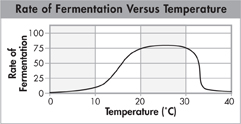Standardized Test Prep
Multiple Choice
What raw materials are needed for cellular respiration?
glucose and carbon dioxide
glucose and oxygen
carbon dioxide and oxygen
oxygen and lactic acid
During the Krebs cycle
hydrogen ions and oxygen form water.
the cell releases a small amount of energy through fermentation.
each glucose molecule is broken down into 2 molecules of pyruvic acid.
pyruvic acid is broken down into carbon dioxide in a series of reactions.
Which substance is needed to begin the process of glycolysis?
ATP
NADP
pyruvic acid
carbon dioxide
In eukaryotic cells, MOST of cellular respiration takes place in the
nuclei.
cytoplasm.
mitochondria.
cell walls.
Which substance is broken down during the process of glycolysis?
carbon
NAD+
glucose
pyruvic acid
The human body can use all of the following as energy sources EXCEPT
ATP in muscles.
glycolysis.
lactic acid fermentation.
alcoholic fermentation.
During cellular respiration, which of the following are released as byproducts?
CO2 and O2
H2O and O2
O2 and H2O
CO2 and H2O
Which of the following is an aerobic process?
the Krebs cycle
glycolysis
alcoholic fermentation
lactic acid fermentation
Questions 9 and 10
The graph below shows the rate of alcoholic fermentation for yeast at different temperatures.
According to the graph, what is the relationship between the rate of fermentation and temperature?
The rate of fermentation continually increases as temperature increases.
The rate of fermentation continually decreases as temperature increases.
The rate of fermentation increases with temperature at first, and then it rapidly decreases.
The rate of fermentation decreases with temperature at first, and then it rapidly increases.
Which statement could explain the data shown in the graph?
The molecules that regulate fermentation perform optimally at temperatures above 30˚C.
The yeast begins releasing carbon dioxide at 30˚C.
The yeast cannot survive above 30˚C.
The molecules that regulate fermentation perform optimally at temperatures below 10˚C.
Open-Ended Response
Explain how a sprinter gets energy during a 30-second race. Is the process aerobic or anaerobic? How does it compare to a long-distance runner getting energy during a 5-kilometer race?
| Question | 1 | 2 | 3 | 4 | 5 | 6 | 7 | 8 | 9 | 10 | 11 |
|---|---|---|---|---|---|---|---|---|---|---|---|
| See Lesson | 9.1 | 9.2 | 9.2 | 9.1 | 9.2 | 9.3 | 9.1 | 9.1 | 9.3 | 9.3 | 9.3 |
Table of Contents
- Formulas and Equations
- Applying Formulas and Equations
- Mean, Median, and Mode
- Estimation
- Using Measurements in Calculations
- Effects of Measurement Errors
- Accuracy
- Precision
- Comparing Accuracy and Precision
- Significant Figures
- Calculating With Significant Figures
- Scientific Notation
- Calculating With Scientific Notation
- Dimensional Analysis
- Applying Dimensional Analysis





